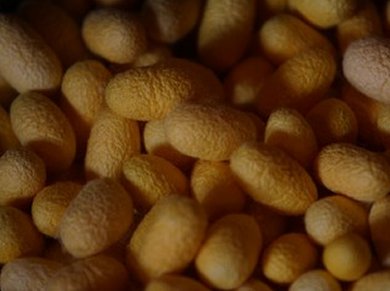Fascinating Materials
Chemists, materials scientists, and engineers often turn to natural substances when it comes to understanding the world around us, not merely to sate their curiosity but for inspiration in developing novel compounds, structural materials, and composites with useful technological properties. One of the perennially fascinating materials to be found in nature is silk.
The caterpillars of numerous species of moth spin protein-based yarn for their cocoons and are known generically as silkworms. Cocoons of about a dozen species provide commercial silks for clothes and other uses. The silkworm, Bombyx mori (B. mori) is cultivated indoors in a highly controlled environment. By contrast, some silkmoths, such as Philosamia Cynthia ricini (P.C. ricini) are reared under semi-domestic conditions or simply collected from the wild. Antheraea assamensis (A. assamensis) and Antheraea pernyi (A. pernyi), for instance, are exposed to the outdoor elements, heat, cold, ultraviolet light, and other stresses, including predators and parasitoids. The cocoon protects the silkworm during the pupal stage of its development from caterpillar to moth.
Protective Cocoons
Xungai Wang and colleagues of Deakin University, Geelong, Australia, the Australian Future Fibres Research and Innovation Centre (AFFRIC), Waurn Ponds, the Australian National University, Canberra, Austrailia, and the Wuhan Textile University, China, have investigated the protection afforded by the silky cocoon of semi-domestic and wild silkworms. Silkworms tend to spin their cocoons in low light conditions but there is always the risk of exposure to harmful ultraviolet from the sun. The cocoon is usually less than 1 mm thick but shields the metamorphosing creature within from visible light. The researchers wanted to know what factors in the cocoon’s structure might preclude the entry of ultraviolet.
Natural UV Protection
They have now performed a systematic investigation based on diffuse reflectance and UV absorbance, as well as measurements of free-radical generation during exposure to UV radiation by using photoinduced chemiluminescence (PICL). This investigation was carried out to reveal the roles, if any, played by fibroin core filaments, the sericin fiber coating, and embedded crystals in the silk cocoon in UV protection. The team found that sericin – a gummy mixture of several proteins that seals a pair of filaments into a fiber and glues this fiber into the cocoon – was mainly responsible for absorbing incident UV-A, UV light of wavelength 320–400 nm. When they removed sericin from the cocoon, they observed much increased photoinduced chemiluminescence indicating that UV-A-induced reactions were taking place within. The sericin mix thus acts as an effective sunscreen for the pupa and also protects the silk fibers themselves from photodegradation. Additional data show that the sericins also provide protection from UV-B (290–320 nm) damage, however, silk fibre itself also shows absorption in UV-B region. Calcium oxalate monohydrate crystals present in the cocoon absorb only UV-C (100–290 nm).
Inspiration for Advanced Organic Photoprotective Materials
Of course, it is well known to those in the silk trade that removing the gum from silk, an obligatory process carried out before spinning for cloth production, makes silk susceptible to light damage. Artificial sunscreen must be added to protect clothing from damage. Moreover, sericin is often used in cosmetics because of its known sun-protection and antioxidant properties. However, the present study offers evidence that sericin in cocoons is the UV-protective agent for silkworms. “The study will inspire development of advanced organic photoprotective materials and designing silk-based, free-radical-scavenging antioxidants,” the team says.
Renowned expert Frantisek Sehnal, head of the Laboratory of Applied Physiology of Insects at the Institute of Entomology in Ceské Budejovice, Czech Repuplic, offers a different perspective on the findings. He points out that the authors allude to the protective effect of aromatic amino acids however these are virtually absent in the sericins, at least those of B. mori and some Antheraea species that have been examined in this respect. Sehnal suggests that unraveling the silkworm cocoon is far from over. “UV protection may be rather based on changes in sericin cross-linking,” he says, “but this is not understood.”
- Photoprotection by Silk Cocoons,
Jasjeet Kaur, Rangam Rajkhowa, Takuya Tsuzuki, Keith Millington, Jin Zhang, Xungai Wang,
Biomacromolecules 2013.
DOI: 10.1021/bm401023h





thanks it is very interesting and significant subject. i want to study more about it